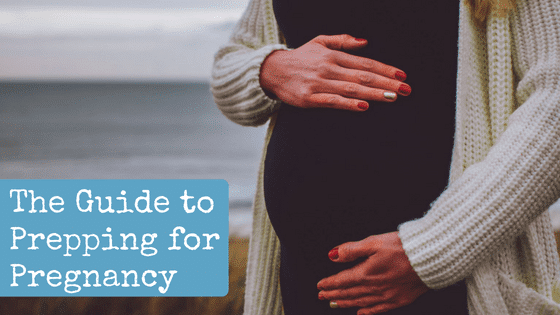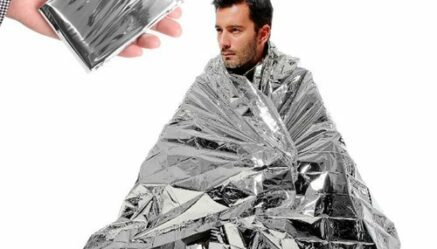This site contains affiliate links. As an Amazon Associate, I earn a commission from qualifying purchases at no extra cost to you. Full Disclosure Here.
A lot of things change once you get pregnant and prepping should be one of those things. You’ll need to be prepared if there’s a possibility you or your wife could have to give birth during a SHTF event. Plus, bugging out doesn’t seem nearly so do-able if you have a pregnant woman or a newborn in your family.
Not only are there supplies to collect, but there’s information you need to have, ideally as soon as you start trying. If you end up never using these supplies, well, they make excellent barter items.
The Importance Of Medical Care
The first thing you should consider if you/your wife is pregnant is how to get them medical care. America has a high maternal, prenatal and infant mortality rate for a developed country. Why? Among the potential contributing factors is lack of prenatal care. Health care workers just aren’t aware of the health conditions of the mom and baby who arrive in the maternal ward.
So, go to prenatal care appointments if you can. You are more likely to suffer from a traditional pregnancy complication than you are to give birth during a power outage or disaster. And, if you do give birth during a disaster, it will be a lot worse if you’re dealing with an undiagnosed condition—whether it’s yours or the baby’s.
You may be planning on a home birth (and more power to you in my opinion). But, if SHTF you may want to reevaluate. If there’s a possibility emergency medical services might stop functioning in the near future, you should carefully consider going to the hospital, because you may not be able to later. And, if you know a nurse, midwife, or doctor who lives nearby, get their contact information, so you can try to call them if SHTF.
Prepping for Pregnancy
Having to go through labor during an emergency is the situation that gets all the attention. But, before that, you could just be pregnant during SHTF and that can be very uncomfortable and outright dangerous in its own right. Once you’re planning to be pregnant, or once you realize you are, you’ll need new supplies at your bug-in location or in your bug out bag.
To Bug Out Or Not To Bug Out?
Speaking of which, your condition might mean you need to take stock of whether your bugging out plans are still practical. Even in the first few weeks of pregnancy, the exhaustion can be debilitating. After that, you’re slow, uncomfortable, your feet are swollen, and extreme physical exertion can be dangerous, even if you’re already quite fit.
If you’re in a situation where you have to bug-out, it may be a better idea to go to a closer shelter than to a bug-out location in another state or deep in the woods. That way, medical help will be easier to reach. If that’s the route you think you’d take, be sure to locate nearby shelters or locations you’d go to for any of your relevant SHTF scenarios.
Pregnancy Supplies For When SHTF
- Prenatal vitamins: if you would normally plan to have pre-natal vitamins during a pregnancy, having enough on hand to get you through a SHTF event is a good idea.
- Larger clothes: Larger dresses, leggings, pants, shirts, bras and shoes (some women’s feet swell a lot) will all be needed. A belly band can help you use your old pants for as long as possible.
- Anti-nausea medication or remedies: morning sickness is uncomfortable, but it can really slow you down when you’re fleeing a SHTF situation. Have your medication or essential oil of choice on hand to help.
- More calories: Mom’s need for calories go up throughout pregnancy. In the first trimester, you don’t need more calories, but you will lose some through morning sickness that you’ll need to replace. In the second trimester you need 300-500 calories more. By the third, it’s 500 calories. If it’s twins or more, you need 500 per extra baby. If you’re gaining one pound a week during the second and third trimesters, you’re likely meeting your calories needs.
- More nutrients: It’s not just calories, pregnant women need more protein, calcium, vitamin C, and iron, for starters. All but the protein should be covered by the prenatal vitamins, so adding extra meat to your meal plan should cover it.
Prepping for Emergency Birth
The Importance Of Knowledge
Learn about birth, the potential complications, and how to give birth on your own. So many things about pregnancy, birth, and having a newborn can be improvised when they have to be. After all, our ancestors did it without modern equipment.
To learn, read these sources:
- The American College of Nurse-Midwives’ “Guide to Emergency Preparedness for Birth”
- Journal of Midwifery and Women’s Health “Emergency Preparedness for Childbirth”
- US Department of Health, Education, and Welfare “Emergency Childbirth”
- Journal of Perinatal Education “Introducing Emergency Preparedness in Childbirth Education Classes” (contains a good list of things you should know/classes to take before birth)
- What to Expect’s “What to do if you have to give birth alone”
- Know the signs of early labour, can happen due to stress
The more you know, the better prepared you’ll be to make do in a crisis. Also, the CDC suggests that you should ask your doctor where you can go if their office/your hospital is closed due to an emergency.
Supplies For Your Emergency Labor Bag
Put all of these items in a separate bag from your bug-out-bag, but keep it in the same place. Ensure the bag is waterproof!
- A good first aid kit that includes at least four large gauze pads (used for external bleeding)
- Scissors (they need to be sharp!) and cord clamps (a boiled and still-wet shoe string works to tie off the umbilical cord too)
- Antiseptic (isopropyl alcohol preferred) and gloves
- Bulb syringe, to gently clear the baby’s airway if necessary
- A plastic liner/trash bag/shower curtain to place beneath mom
- A flashlight or headlamp, in case you give birth in the dark
- Blankets to receive the baby, separate blankets for mom, a hat for the baby
- A hot water bottle to help keep baby warm
- Feminine pads, heavy and many, plus a bowl or garbage bag for the placenta
- Newborn diapers
- Squirt bottles (for cleaning mom afterwards)
- Pain medication (advil or tylenol, given after the placenta is delivered/bleeding from womb has stopped)
- Ice pack for mom’s sore spots
Once healthcare is available, call authorities to you, or bring yourself and the baby in. Right away.
Prepping with a Newborn
Bugging Out With A Baby?
You may want to change your bug-out plan based on having a new child. It may be smarter to go to a formal shelter, which may be more likely to have baby supplies, than your bug-out. Bugging out in general may take a backseat to bugging in unless absolutely necessary, because at least at home you know you have months of baby supplies (or, you should). Like with all life changes, evaluate your plans with your new baby in mind.
Newborn And Young Baby SHTF Supplies
- Formula and bottles: Even if you intend to breastfeed, lack of nutrition or stress in a SHTF scenario may prevent you from producing enough milk, even if you’ve been successfully breastfeeding before the event. You need formula as a back-up. And, like other liquids and foods, when SHTF has made things unsanitary, you should make formula three times a day instead of all at once. It’s less likely to get contaminated then.
What if baby is old enough for baby food? Grind up your food, add liquid if it’s dry, and feed it to the child. Be sure to learn about your baby’s nutritional needs beforehand.
- Vitamin D supplements: Breast milk does not provide an infant with enough vitamin D even if the mother has an excess. If the SHTF event allows the child access to the sun, they may be able to make enough for themselves. If they must be confined indoors for safety, they may become Vitamin D deficient and develop rickets. It’s rare, but it happens. The American Academy of Pediatrics recommends the child get a supplement of 400 UI of vitamin D per day after birth. (If the child is on formula, it should already be vitamin D fortified. Four cups of formula a day is enough to hit a baby’s vitamin D needs.)
- Diapers and baby wipes: Sanitation is a huge concern during SHTF and babies are especially vulnerable. Extra cloths, like burping pads, are also going to be invaluable. You can make some out of any rags you have lying around though, so I wouldn’t necessarily waste valuable room in a bug out bag for them.
- Blankets and clothes of various sizes: If you have hand-me downs, you’ll likely be able to make due when SHTF. But if this is your first child, have at least three sets of each stage of baby clothing ready at home. Usually, they are: 0-3 months (some babies never fit in this size), 3-6 months, 6-9 months, 9-12 months, 12-16 months, 16-24 months, 2 T (“T” stands for toddler), 3T and 4T. If you expect a newborn, put some of the larger clothes in the bug out bag– it’s okay if its big as long as the baby is warm and can breathe.
- Baby carrier: In a pinch, a sling of any kind of cloth can be made. But, a more formal carrier or stroller may might life a lot easier after SHTF.
- Baby powder and diaper rash cream: Anything you can do to make the baby more comfortable.
- Other medications: Baby cough medicine, baby Advil (only used past 6 months), etc.
- Documents: If you’re fleeing from a crisis and you have a birth certificate for your child, keep it with them. If the child was born during SHTF, it may be smart to put an identifying wristband on them. Sadly, children and parents do get separated during an emergency. Some children even become orphans (God forbid), so you want to make it easy for an adult to identify your child so they can find you or next of kin.
- Teething toys: Depending on the age of your child, having teething toys may be an important investment. The first baby tooth may erupt as early as 6 months.
Prepping as a New Mom
We’ve covered what extra supplies the baby will need during SHTF, but a new mom has her own needs too.
- Extra water: Water is always essential, but breastfeeding women will need more of it than usual. Unfortunately, these water needs can vary greatly so it’s hard to plan. The average breastfeeding mom drinks 0 liters a day, but more if she is older. The average 50 year old mom drinks 3.6 L. So, I would have slightly more on hand per day. No need to force yourself to drink though—if you’re not thirsty you’re fine.
- Extra food: Breastfeeding mothers need extra food too. You should plan for an extra 450-500 calories for a breastfeeding woman, assuming she isn’t trying to lose baby weight. It’s also important the mother gets more than her normal macro and micro nutrient needs, so she can pass the excess onto the baby.
- Birth control: You can get pregnant again very shortly after birth. If SHTF you might not be able to pop into a pharmacy and get birth control, so it’s a good idea to have some on hand. Breastfeeding only protects you from a new pregnancy if your body fat percentage is very low, under 18 percent, which could happen if SHTF. But you don’t want it to be that low, because you might compromise your health and the baby’s.
Have I missed things? I’m sure I have. After all, it’s a whole other life you’re planning for here. Let me know in the comments what you would add to this, especially you experienced prepper parents out there.
Author Bio: Ellysa Chenery can be found writing all over the web. She loves adapting traditional skills for new situations, whether in the wilderness, garden, or homestead. Her favorite smell is carrots fresh from the dirt.
If you enjoyed this article, consider following our Facebook page.












![Top 12 Best Foraging Books [Worth To Read]](https://www.backdoorsurvival.com/wp-content/uploads/2018/03/The-Best-Foraging-Books-Worth-Reading-wide-70x70.png)



2 Responses to “The Guide to Prepping for Pregnancy”
A very well-written and useful guide for all mummy to be’s. Abudo maternity course is also full of advice and care.
Plain flour can be used to make an effective diaper rash formula. Brown it in a dry Iron skillet… allow it to cool and use as a powder.Improvement is noted by the next diaper change.